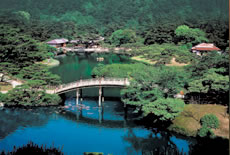
Ritsurin Garden, at 75 hectares, is Japan’s largest Cultural Property Garden, created by nature, man, and time. Stepping into the garden, you can see an ever-changing variety of landscapes, and people never grow tired of this delightful space for rest and relaxation. Ritsurin Garden has earned a reputation both in Japan and overseas, earning the Michelin Green Guide's highest rating of three stars in its Japan Edition, and its unchanging tradition of beauty continues to the present day. Of its many seasonal transformations, the spring cherry blossoms and the autumn leaves are especially noteworthy, particularly when the park is illuminated on spring and autumn evenings, giving the colors of the cherry blossoms and maple leaves a mysterious cast.
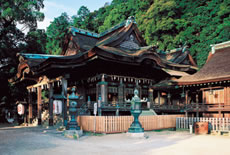
Kotohira-gu Shrine has attracted throngs of worshippers devoted to the god of the sea since ancient times. Nowadays, it is a “must-see” for any visitor to Kagawa Prefecture, and is always crowded with worshippers and visitors. Kotohira-gu Shrine is famous for its long stone stairway, with 785 steps leading from the entrance of the worship path to the main hall and a total of 1368 steps leading from the entrance to the interior shrine. Many souvenir shops line the approach all the way to the main gate, and as you come nearer to the main shrine, you can see buildings that have been designated Important Cultural Properties. Nearby, Japan’s oldest existing playhouse, Kanamaru-za, still serves as a venue for kabuki performances, which are considered a feature of spring in Shikoku.
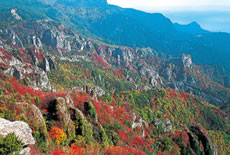
Shodoshima Island floats on the Seto Inland Sea, and it is one of Japan's greatest production areas, with its famous products of somen noodles, soy sauce, tsukudani, sesame oil, olives, etc. Shodoshima is particularly well known for being the birthplace of olive production in Japan. It is also famous as the setting of the movie, Twenty-four Eyes. Among the terrific sightseeing places on this island, Kankakei Gorge, one of Japan's Three Great Gorges, especially stands out for its scenic beauty. Here you can see a different expression of natural beauty with each changing season. The gorgeous colors of the autumn leaves here are the gorge's highlight. Formed by volcanic activity 13 million years ago, it was subjected to countless years of erosion, which created its present form in what one might call “Nature’s own modeling.” Many visitors take a "walk in the clouds," so to speak, as they ride the five-minute aerial ropeway up or down the gorge.
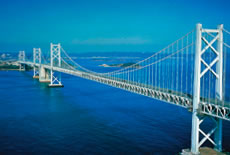
The Seto Ohashi Bridge crosses some of the Seto Inland Sea's most beautiful islands and links Honshu and Shikoku. The structure referred to as “the Seto Ohashi Bridge” is actually made up of six bridges that together span a 9.6-kilometer strait. It was completed in 1988, about a century after the idea was conceived. People both inside and outside the region love this spectacularly placed bridge as the embodiment of their predecessors’ hopes.
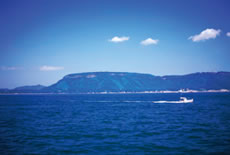
Thrusting out into the Seto Inland Sea like a tabletop, Yashima is a volcanic plateau that was once an island. It got its name, which means “Roof Island,” from its resemblance to a flat roof. The view of the Seto Inland Sea from Yashima is said to be one of the finest, allowing the visitor to see the whole expanse of the Sanuki Plain and the ships that travel back and forth among the lovely islands.

